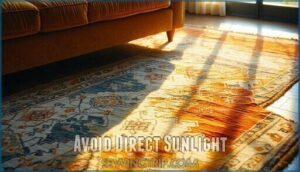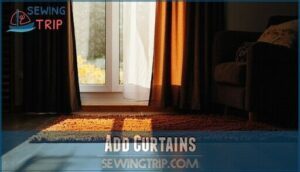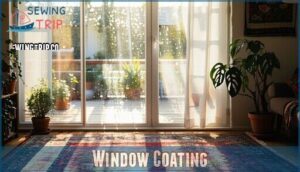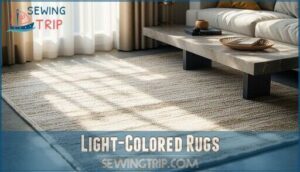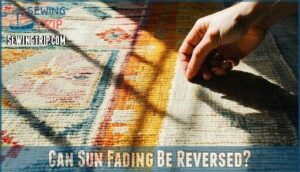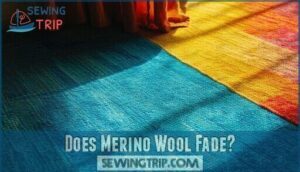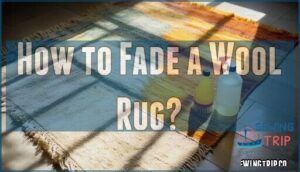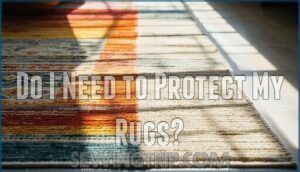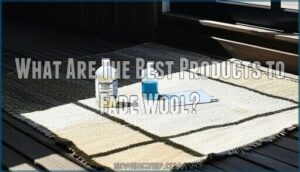This site is supported by our readers. We may earn a commission, at no cost to you, if you purchase through links.
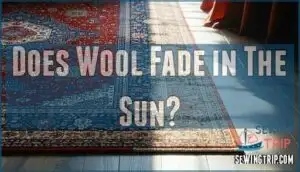
Wool absolutely can fade when exposed to direct sunlight, thanks to harmful UV rays that break down its natural fibers.
The process is gradual but inevitable – your beautiful wool rugs and fabrics will slowly lose their vibrant colors and become dull over time.
Darker colored wool tends to show fading more dramatically, so you’ll want to protect your investment.
Consider using window treatments, rotating your rugs periodically, and minimizing direct sunlight exposure.
Strategic placement and simple protective measures can dramatically slow down the sun’s color-stealing effects, keeping your wool looking fresh and rich for years to come.
Table Of Contents
- Key Takeaways
- What is Sun Fading?
- Does Wool Fade in The Sun?
- How to Prevent Sun Fading?
- Can Sun Fading Be Reversed?
- Does Wool Carpet Fade in Sunlight?
- Does Merino Wool Fade?
- How to Fade a Wool Rug?
- Do I Need to Protect My Rugs?
- What Are The Best Products to Fade Wool?
- Frequently Asked Questions (FAQs)
- Conclusion
Key Takeaways
- Wool fades in the sun due to UV rays breaking down its natural fibers, with darker colors fading faster than lighter ones.
- Protect your wool rugs and fabrics by using curtains, UV-blocking window films, or rotating them regularly to minimize sun exposure.
- Merino wool has greater UV resistance compared to other types but still requires care to avoid prolonged sunlight damage.
- You can reduce fading risks by choosing lighter-colored wool items, applying protective treatments, and avoiding direct sunlight.
What is Sun Fading?
Sun fading occurs when UV radiation breaks down the molecular bonds in fabrics, causing permanent color degradation that can’t be undone.
UV rays act like a silent thief, gradually stealing the vibrant colors from your fabrics over time.
Think of it as your textiles getting a sunburn – the damage builds up over time until you notice those once-vibrant colors looking washed out.
The process happens through chemical changes in your fabric’s fiber structure.
When sunlight hits wool, cotton, or synthetic materials, it triggers reactions that alter the dye molecules.
This leads to fabric discoloration that starts subtly but becomes more noticeable with continued sun exposure.
Several fading factors determine how quickly your textiles lose their original appearance.
The intensity of sunlight, duration of exposure, and your fabric’s color all play key roles.
Darker materials absorb more heat and often show UV damage faster than lighter shades.
While wool is susceptible, polyester offers resistance due to its colorfast properties.
Understanding textile fading helps you make smarter choices about where you place your rugs and furniture.
When you know how sun exposure affects different materials, you can take steps to preserve your home’s beauty.
Does Wool Fade in The Sun?
Yes, wool can fade in the sun, though it’s naturally more resistant to UV damage than synthetic materials.
You’ll notice fading can occur in as little as six months without proper protection, especially with darker colors that absorb more heat and light.
Wool Rugs
Wool rugs face significant fading risks from sun exposure, with darker colors absorbing more heat and showing UV damage faster.
Your rug’s lifespan can drop by half without proper protection.
Rug fiber types, weave impact, and dye quality all influence fading rates.
Regional styles from China, Pakistan, and India with luster washes prove especially vulnerable to cleaning effects and sunlight deterioration, which can be considered a significant fading risk due to UV damage.
Natural Fabrics
Among natural fabrics, wool stands out for its superior UV resistance compared to cotton and silk.
While synthetic materials often lack fiber strength against sun exposure, wool’s protein structure provides better color fastness.
However, fabric composition matters – wool blends may fade differently than pure wool.
Dye types also influence how natural fibers respond to sunlight.
You’ll find that wool fading occurs gradually, but it’s still vulnerable without protection.
Cotton and linen show damage faster, making wool a smarter choice for sun-exposed areas in your home, due to its superior UV resistance and better color fastness.
Darker Colors
Why do darker wool colors seem to disappear faster than their lighter counterparts?
The answer lies in heat absorption and dye concentration.
Darker shades absorb more sunlight, accelerating color degradation and reducing UV resistance.
Your beautiful deep-toned wool fades at alarming speeds when exposed to direct sun exposure.
The concentrated dyes in darker colors break down quicker under sunlight effects, making wool fading inevitable without proper protection against these harsh conditions and the impact of sunlight.
Wool Protection
Beyond basic shade, your wool needs active defense against UV damage.
Professional wool protection involves UV treatments that create invisible barriers around fibers.
Smart dye selection during manufacturing helps, while proper wool storage away from windows extends lifespan.
Fiber blends often resist fading better than pure wool, and regular cleaning methods using gentle products maintain protective qualities.
Preventing sunlight effects from causing permanent wool fade through thorough fading prevention and diligent wool care practices is essential, involving proper wool storage to ensure the longevity of the wool.
How to Prevent Sun Fading?
You can protect your wool rugs from sun damage by controlling their exposure to UV rays and implementing simple preventive measures.
Protect your wool rugs by blocking UV rays and rotating them regularly to preserve their vibrant colors and longevity.
The key strategies include blocking direct sunlight with window coverings, choosing lighter-colored rugs that resist fading, and rotating your rugs regularly to guarantee even wear patterns.
Avoid Direct Sunlight
The most effective wool protection strategy involves keeping your rugs away from direct sunlight completely.
Position furniture to block harsh rays, especially during peak hours when sunlight intensity reaches its maximum.
Exposure duration matters more than you think—even brief daily contact accelerates sun fading.
In coastal regions where UV radiation is stronger, this fading prevention approach becomes absolutely critical for maintaining your wool’s original beauty and preventing premature deterioration, which is why sunlight intensity and UV radiation are key factors to consider.
Add Curtains
Curtains act as your first line of defense against sun fading, creating a protective barrier between harmful UV rays and your precious wool rugs.
The right curtain setup can dramatically reduce fade damage while maintaining your home’s natural lighting.
Consider these effective curtain strategies:
- Thick, lined curtains block more UV radiation than sheer fabrics
- Dark-colored curtains absorb UV rays before they reach your rugs
- Automated curtains adjust throughout the day for consistent UV protection.
For enhanced UV protection, consider purchasing lined options.
Window Coating
Window film offers three main coating types for UV protection: ceramic, dyed, and metalized films.
Professional application methods guarantee proper UV absorption, blocking up to 99% of harmful rays that cause wool fade.
While coating lifespan varies from 10-25 years, the cost analysis shows significant savings compared to replacing sun-damaged rugs.
Consider exploring options for UV coating to protect your rugs, as this window coating prevents sun fading effectively, providing a solution for UV protection.
Light-Colored Rugs
Light-colored rugs offer superior fading resistance compared to darker alternatives.
When sunlight hits these rugs, they naturally reflect more light, reducing heat absorption that accelerates wool fade.
Here’s why they’re your best defense against sun fading:
- Sunlight Reflection – Light colors bounce UV rays away
- Perceived Brightness – Maintain vibrancy longer than dark rugs
- Stain Visibility – Shows dirt requiring frequent cleaning
- Design Limitations – Fewer bold pattern options
- Cleaning Frequency – Needs more maintenance
Rug Protectors
You can shield your wool rugs from sun fading with specialized rug protectors that create a barrier against harmful UV rays.
These protective treatments enhance your rug material’s natural fading resistance, especially when combined with avoiding direct sunlight exposure.
Different protector types offer varying levels of UV resistance, from spray-on solutions to professional treatments.
You can find a suitable wool rug protector online, and investing in quality rug protectors substantially extends your wool rugs’ lifespan and color vibrancy, while the cleaning impact and cost analysis vary by product.
Can Sun Fading Be Reversed?
Sun fading might seem like the end of your wool rug’s story, but professional restoration can breathe new life into damaged fibers.
While complete reversal isn’t always possible, skilled textile specialists offer several effective solutions:
- Professional cleaning – Expert soil removal and specialized treatments restore vibrancy by clipping pile surfaces
- Re-dyeing wool – Color restoration using precision dye matching techniques revitalizes faded areas
- Hydrogen peroxide treatments – Controlled chemical processes help even out discoloration patterns
- Professional restoration – Textile conservators assess damage extent and recommend appropriate dye restoration methods
Wool rugs can still fade, even though they’re more resistant fabrics.
Does Wool Carpet Fade in Sunlight?
Wool carpet does fade in sunlight, and understanding this reality helps you protect your investment.
Direct sunlight creates carpet fiber damage through UV exposure effects, breaking down the natural proteins in wool fibers over time.
Your wool carpet’s color degradation rate depends on several factors.
Darker colors absorb more heat and show fading faster than lighter shades.
The sunlight intensity impact varies by location and season – south-facing windows pose the greatest threat during peak afternoon hours.
Implementing preventative carpet measures makes all the difference.
Install blackout shades or heavy curtains to block harmful rays.
Window films offer another layer of protection without sacrificing natural light completely.
Consider moving furniture periodically to prevent uneven fading patterns.
Rug rotation every six months guarantees even wear and prevents permanent sun damage in high-exposure areas.
Steam cleaning followed by sun drying accelerates wool fading, so always dry carpets indoors.
Remember, wool’s natural resilience gives you an advantage, but consistent protection keeps your carpet looking vibrant for years.
Preventative carpet measures and consistent protection are key to maintaining your wool carpet’s appearance.
Does Merino Wool Fade?
Everyone wonders whether their beloved merino wool items will lose their vibrant colors when exposed to sunlight.
Merino wool demonstrates exceptional UV resistance, naturally blocking over 95% of harmful radiation that causes sun fading. However, even these premium wool fibers aren’t completely immune to color changes over extended periods. One factor is that wool can fade, especially if unprotected.
Here’s what makes merino special:
- Merino UV Resistance – Natural fiber structure provides superior protection compared to synthetic materials
- Merino Dye Stability – High-quality processing creates stronger color bonds that resist fading
- Merino Fiber Density – Tightly woven structure blocks more UV rays from penetrating
- Merino Color Fastness – Professional dyeing methods enhance resistance to wool fading
Your merino care impact matters substantially. Rotate your rugs regularly, use gentle cleaning methods, and limit direct sunlight exposure. While merino won’t fade as quickly as other materials, protecting it guarantees lasting beauty.
How to Fade a Wool Rug?
Creating deliberate fading effects on your wool rugs requires careful technique and patience.
You can achieve controlled sun fading through several proven methods that work with wool’s natural fiber structure.
Here are three effective approaches for intentional rug fading:
- Hydrogen peroxide solution: Mix with water in a 1:10 ratio and apply evenly
- Controlled direct sunlight: Place your rug outside for 1-3 hours during peak hours
- Professional cleaning treatments: Use luster wash techniques for gradual color reduction
Always monitor moisture control during the process to prevent fiber damage and guarantee even results.
Do I Need to Protect My Rugs?
Yes, you should protect your wool rugs because even though wool is naturally UV-resistant, prolonged sun exposure can still cause fading in as little as six months.
Without proper protection, your rug’s lifespan can be cut in half due to UV damage that breaks down pigment molecules and alters the wool’s structure, which is a critical consideration for maintaining your rug’s integrity and extending its lifespan, especially since this damage can lead to significant fading.
Use Coverings
Window coverings offer your best defense against UV rays that damage wool rugs.
Curtain materials like heavy cotton or linen block more light than lightweight fabrics. Different blind types provide varying protection levels, with blackout options delivering maximum coverage.
Window film application creates an additional barrier, while sheer effectiveness depends on fabric density. These coverings protect wool from gradual sun damage, which is why window coverings and UV rays are crucial considerations.
Protective UV Filters
UV filters offer your best defense against wool fading prevention by blocking harmful UV rays before they reach your rugs.
These invisible shields substantially boost filter effectiveness while providing long-term sun protection for your wool treatment needs.
- Window films: Apply professional-grade UV blocking films using proper application methods for maximum coverage
- Chemical treatments: Use specialized wool treatment solutions that enhance natural fiber resistance to UV damage
- Cost comparison: DIY filters cost less upfront but professional installations offer better filter lifespan and durability
Light Bulb UV Exposure
Beyond window protection, indoor lighting deserves attention too.
Many people don’t realize their light bulbs can accelerate wool fading through UV emission.
Standard incandescent and fluorescent bulbs produce UV rays that gradually weaken wool fibers’ lightfastness over time.
| UV Bulb Types | Fading Effects | Safe Alternatives |
|---|---|---|
| Incandescent | Moderate UV emission | LED bulbs |
| Fluorescent | High UV output | Halogen with filters |
| Halogen | Variable UV levels | UV-filtered options |
| LED | Minimal UV rays | Best choice overall |
Choose LED bulbs for rooms with wool rugs—they’re your safest bet against indoor UV damage.
Rotate Rugs
Rotating your wool rugs regularly is a simple way to guarantee even wear, maintain color consistency, and extend their lifespan.
By shifting their position, you prevent damage from prolonged exposure to direct sunlight, which accelerates sun fading.
Aim for a rotation frequency of every six months.
Pair this with rug protectors, window films, or curtains to block UV rays.
These steps also safeguard your rugs but also keep them looking vibrant for years.
What Are The Best Products to Fade Wool?
If you’re looking to lighten wool, there are several effective products to examine.
Hydrogen peroxide is a popular choice for gently fading wool without causing damage.
For a safer approach, try color-safe bleach or diluted bleach solutions, which work well on natural fabrics like wool.
Luster washes can also help achieve a lighter tone, though they may weaken the wool’s cuticles over time.
Commercial wool fading solutions, specifically designed for controlled color reduction, offer predictable results without compromising fabric integrity.
Even substantially yellowed wool can be rejuvenated through bleaching, so review hydrogen peroxide mixtures.
To protect your wool during the process, make certain you’re using UV filters or applying protective coatings like window film to block UV rays.
Always test products on a small area first to avoid unexpected results and maintain wool quality.
Frequently Asked Questions (FAQs)
Do wool rugs fade in sunlight?
Yes, wool rugs can fade in sunlight over time.
Direct exposure breaks down dye pigments, especially in darker colors.
Protect them by using UV-blocking window treatments, rotating rugs, or choosing lighter colors and patterns.
Does wool fade faster in sunlight?
Wool can fade in sunlight, but how fast depends on factors like dye concentration and exposure time.
Darker wool colors absorb more heat, making them slightly more prone to fading than lighter shades over time.
Can You fade wool?
You can fade wool by exposing it to sunlight or using solutions like hydrogen peroxide, but it’s tricky.
Wool’s natural resistance to fading means these methods need patience and care to avoid damaging the fibers.
Which Rugs will not fade in the Sun?
Rugs made from synthetic fibers, like nylon or acrylic, resist sun fading better than natural ones.
Merino wool is highly durable but needs care.
Use UV-protective treatments or window coverings to preserve your rug’s color.
Why do wool rugs fade?
Strong sunlight can gradually weaken wool rugs, causing their vibrant colors to fade.
This happens as UV rays break down pigments and alter wool’s molecular structure over time, especially with prolonged exposure to direct sunlight.
Will wool drapes fade after long exposure to the Sun?
Imagine sunlight as a slow artist altering a masterpiece—your wool drapes can fade over time with prolonged sun exposure.
Use UV-blocking window films or curtains to protect their beauty and extend their lifespan.
Will wool fade in the sun?
Yes, wool fades in sunlight over time.
While it’s more resistant than many fabrics, prolonged exposure can cause color changes.
Use curtains, UV-blocking films, or keep wool items shaded to prevent fading.
Can you leave wool in the sun?
You can leave wool in the sun, but prolonged exposure will cause fading and weaken its fibers.
Protect it by limiting sunlight, using UV-blocking treatments, or covering it with curtains or window films.
Is wool bad to wear in the summer?
Wool’s lightweight breathability makes it a surprising summer hero.
It wicks moisture, resists odor, and keeps you cool in heat.
Avoid darker shades under direct sun, as they absorb heat faster than lighter tones, which is a key concept to consider for summer comfort.
What is the effect of sunlight on wool?
Sunlight affects wool by gradually altering its color and weakening its fibers, especially with prolonged exposure.
Darker shades resist fading better, but UV rays can still cause photoyellowing.
Protective measures help minimize damage and extend wool’s life.
Conclusion
Protecting your wool from sun exposure is like shielding a precious painting from damage—it’s essential for preserving its beauty and lifespan.
Yes, wool fades in the sun, but you can minimize its impact with strategic steps.
Use curtains, UV filters, or rearrange rugs to limit direct sunlight.
Rotate rugs regularly to even out exposure and consider lighter colors for less noticeable fading.
With proper care, your wool pieces can stay vibrant and timeless for years to come.
- https://iwto.org/wp-content/uploads/2024/06/IWTO-Wool-Notes-2024.pdf
- https://www.researchgate.net/publication/227928717_Photoyellowing_of_wool_Part_1_Factors_affecting_photoyellowing_and_experimental_techniques
- https://fiberseal.com/2023/12/08/fabric-fading-the-truth-about-uv-fabric-protectors/
- https://www.canada.ca/en/conservation-institute/services/preventive-conservation/guidelines-collections/textiles-costumes.html
- https://www.sciencedirect.com/science/article/am/pii/S0141391020302500

